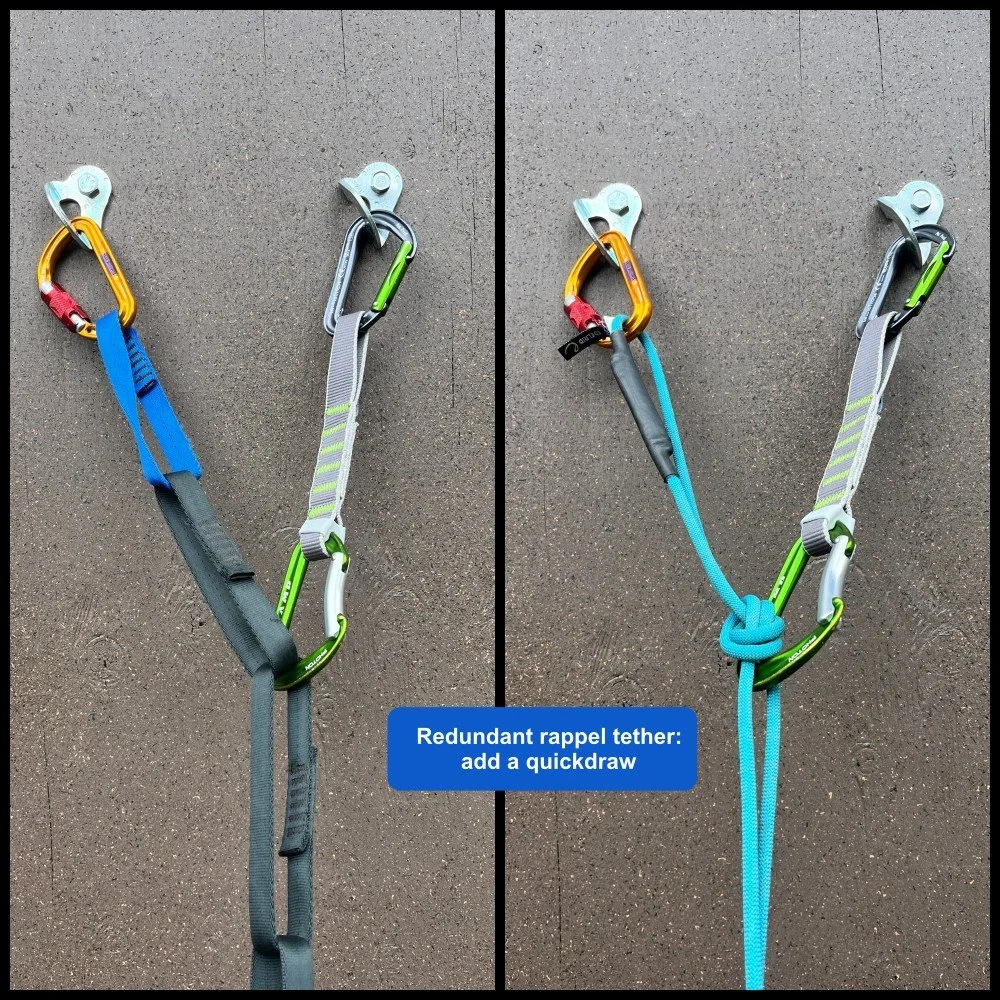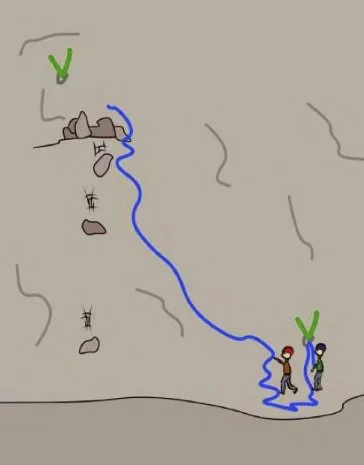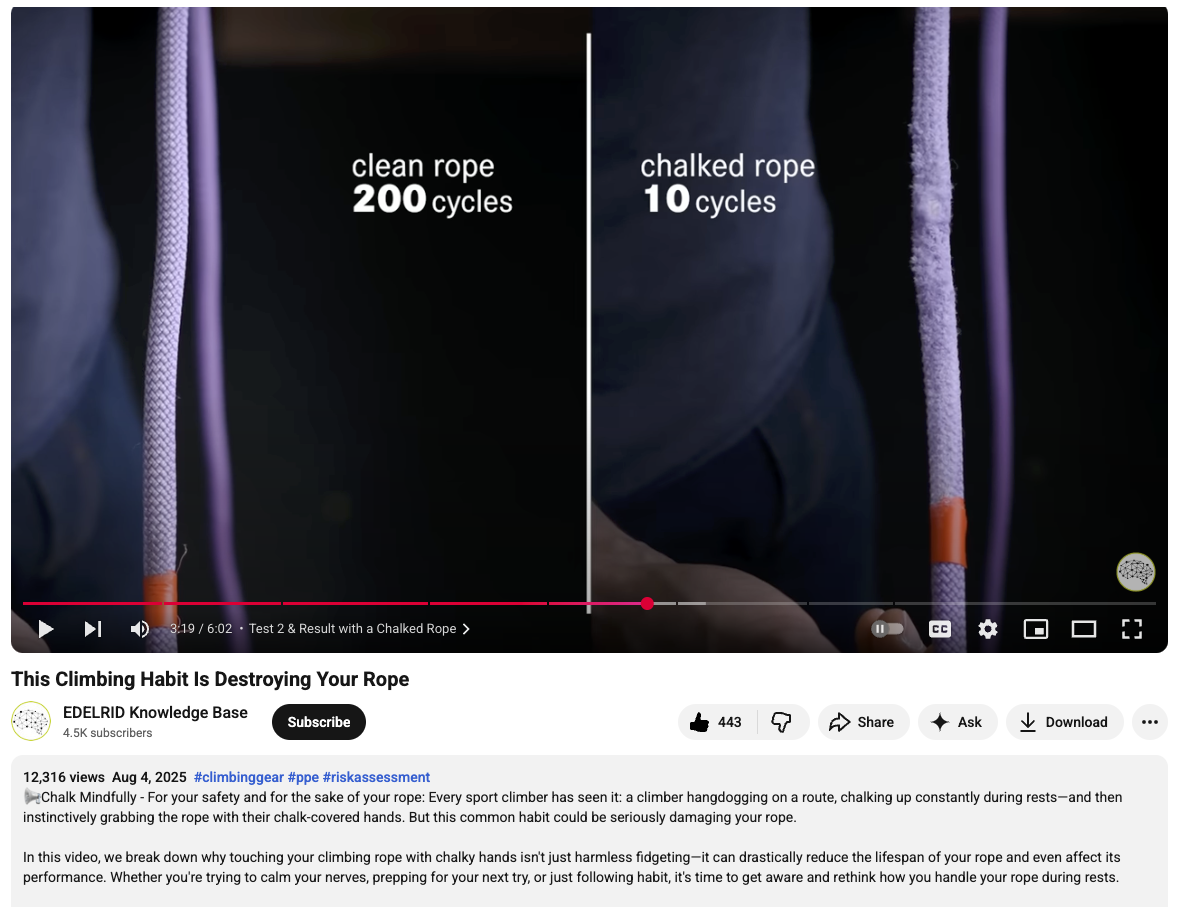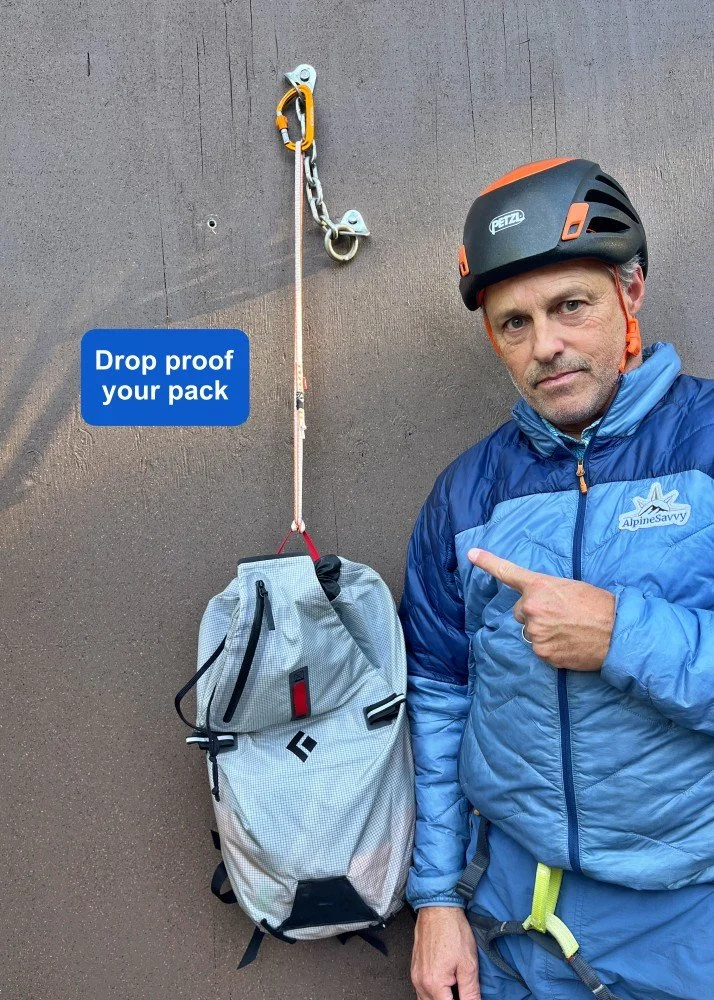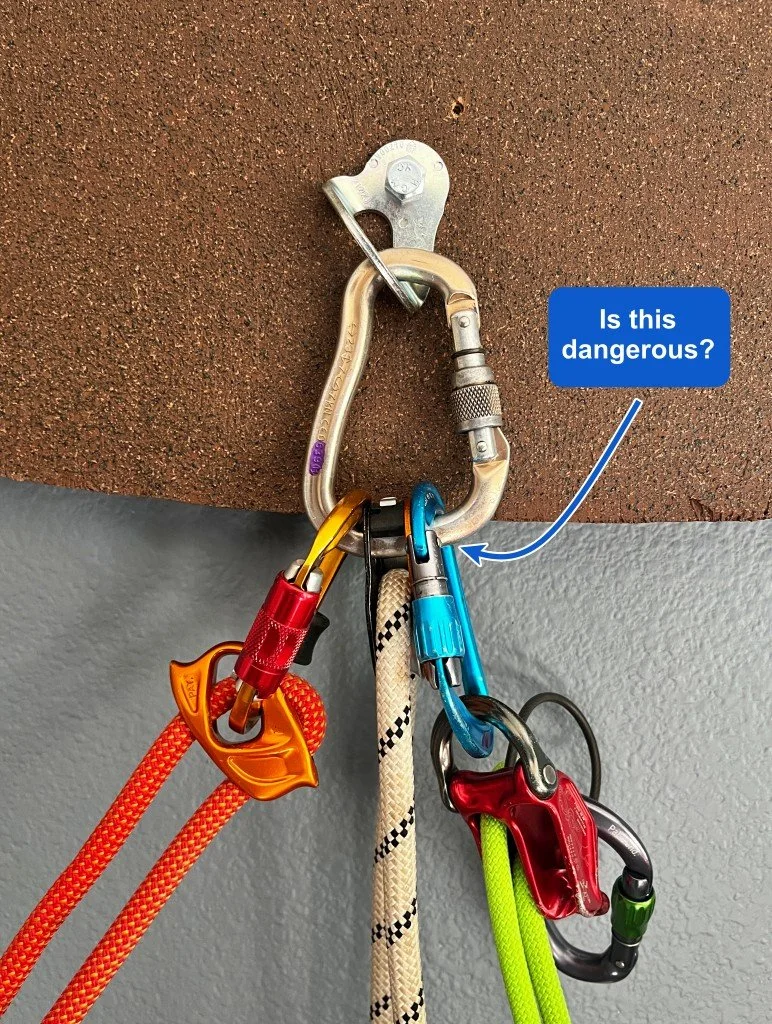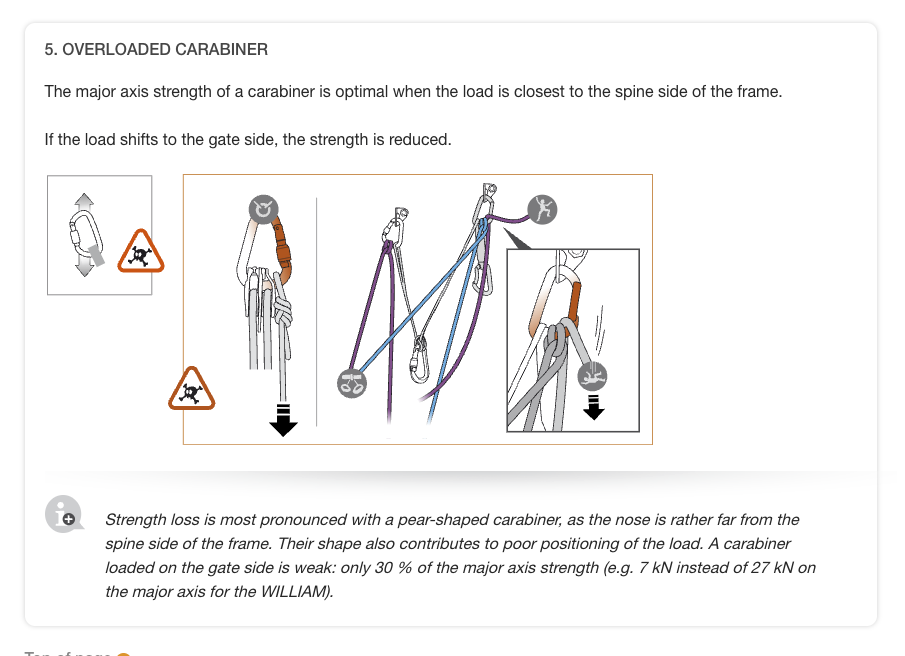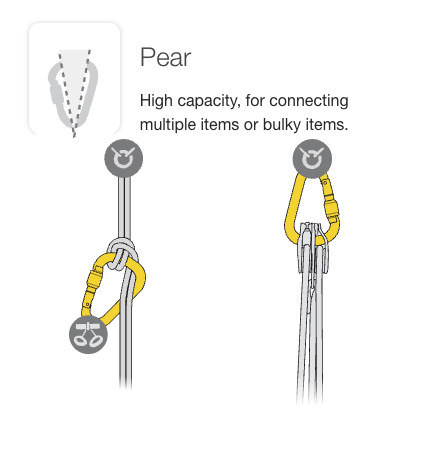Practice rope ascending on a top rope
Proper training for your first big wall involves lots of rope ascending and related skills like cleaning, lowering out, and other rope trickery. Here's a simple way to set up a practice session with you and your partner to always stay secure.
The image below is from the outstanding online big wall climbing course from VDiff climbing. It's a great course and quite a bargain; highly recommended!
Want to climb a big wall? Dialing in your rope ascending and cleaning techniques is key.
Here's a way to reduce risk when practicing these skills.
Set up a solid top rope anchor. On that same anchor point or something very close by, hang a single fixed rope.
Now, as you ascend the fixed rope (green) you're always backed up with a proper belay from your partner on the top rope (red). Now you can practice things like cleaning a traverse, leapfrogging past fixed gear, cam jugging, lowering out, maybe doing a mock lead, and other big wall shenanigans.
If you screw up anything on the green rope, no problem! You're backed up on red.
(This also applies to non-bigwall flavors of rope ascending, like prusiking for crevasse rescue practice.)
image: https://vdiffclimbing.thinkific.com/courses/take/big-wall/lessons used with permission
Backup that single strand rappel anchor
Does rappelling off of a single strand of cord give you a warm fuzzy feeling? No, me neither. Here's a quick way to back it up.
Do you want to rely on a single strand of cord in ANY part of your climbing system to keep you from hitting the deck? I didn't think so.
Don't settle for that in a rappel anchor.
If you come across an anchor with a single piece of cord or webbing, it's good practice to back it up by tying another piece of cord or webbing through the existing ring / quicklink(s). This is quick to tie, very low cost, and easy to check for anyone else using the anchor.
This is one more good reason to carry 7-ish meters of 6 mm cord, and a knife.
If you're wondering about the redundancy of that single red aluminum ring . . . It's rated to 32 kN. That's stronger than your rope, your belay loop, and your belay carabiner.
It's never gonna break, and you only need one of them.
(But hey, if it gives you a warm fuzzy feeling to add a quick link, extra rappel ring or a cheapskate locker to have another connection at the master point, go right ahead! We are all accountable for our level of acceptable risk, no one else gets to dictate that.)
Knots decrease sling strength - one may surprise you
Tying knots in any sort of rope or cord decreases the strength of that material. Usually, we think that strength can't be reduced more than about half. But there's one unusual case where you can lose almost 75% of the strength of a sling; check it out here.
image: Jürgen Reinmüller, @alpinstil.at
This nice diagram is from Jürgen Reinmüller, @alpinstil.at.
Jurgen is an Austrian mountain guide who is publishing a how-to technical book, with the publication date planned for spring 2026. (To get an reminder email when the book is available, sign up through his Instagram Bio.)
He posts nice diagrams from the book on his Instagram, and this is one of them.
This should be fairly common knowledge for most climbers:
A sewn sling gets its full rating (22-ish kN) when clipped end to end.
If you basket hitch the sling, you share the load among four strands rather than two, so the strength is approximately doubled.
If you tie a knot in the sling (or more than one knot, as it turns out) you reduce the strength by about half.
So far so good . . . but that last example that made me scratch my noggin when I first saw it.
That seems like it would be closer to 50%, because you have 2 knots in the sling, right?
Well, turns out this diagram is correct. You're putting the load on one strand rather than two. Then, you're tying knots in that one loaded strand rather than two. Taking half of the material and reducing the strength by half gets you to around 25%.
How do I know Jurgen is right? Because I sent it to my buddy Ryan at HowNOT2, and he was nice enough to do a break test for me.
The video is below.
Ryan ran several tests. Two of them used a dynamic sling, which slipped in the testing machine so he didn't get a good result. The video below is of a nylon sling, which is a little grabbier and didn't slip.
The normal breaking strength that sling should be around 24 kN if you pull it it end to end; it broke around 6 kN.
Jurgen, thanks for teaching me something new, and I definitely look forward to reading your book.
Multidirectional gear anchor
It's often helpful for your trad anchor to be able to take a strong upward pull. Here's a fast and simple way to do this with minimal gear.
In some situations, it can be good practice to be sure your gear anchor can handle a strong upward pull.
As in the diagram below, when you're doing a fixed point lead belay off the anchor.
You have a heavy climber and a lightweight belayer, and there's a chance of the belayer getting launched into the air when they catch a fall.
Bolts, of course, are multidirectional. Cams, to a lesser degree, are also multi directional because they can usually pivot if the direction of force changes.
Most passive gear, like stoppers, are usually not multidirectional. In a typical anchor, they might be great for a downward pull, but have very little security if they suddenly take an upward pull.
There are a few ways to do this. Assuming you have some kind of gear placement down around your feet that can take an upward pull, this method is simple and effective.
Clove hitch yourself to the master point.
Take the rope from the backside of your clove, and clove hitch it to the upward directional piece by your feet.
Voilà, your anchor can now take an upward pull.
image credit: Georg Sojer / Chris Semmel / VDBS
Redundancy at anchors with a rappel tether
If you’re using a knotted sling or a sewn loop PAS as a rappel tether, here's a simple way you can easily connect to two bolts if you need to. (Redundancy, yeah!)
A tether of some kind is pretty much mandatory when rappelling, so you can clip yourself into the anchors. If you use a 120 cm sling with knots, or a commercially made “Personal Anchor System”, aka PAS, with sewn loops, here’s one extra benefit.
If you're a redundancy fan, being connected to more than one anchor point probably gives you a warm fuzzy feeling - whether you're rappelling or in most any other situation. Here's how to easily do it with this style of tether.
Clip the end of your tether to one bolt
Clip a quick draw to the second bolt
Clip the bottom of the quick draw into one of the middle loops on your PAS. Bang, instant redundancy, while maintaining the full length of your PAS!
You can’t really do this with a tether made from a single length of cord, such as the Petzl Connect Adjust. (Well, I suppose you could, but you'd have to tie a clove hitch or something in the middle of it, and that's not quite as elegant.)
If the bolts are solid, and you're standing on a nice ledge, then you probably don't need to do this. But if you're at a hanging belay, and one or more bolts is less than ideal? You probably want to be clipped to both bolts.
(For the Redundancy Polizei: yes, this is technically not 110% redundant, because you are on one tether instead of two. This is more a quick fix for when you encounter a substandard bolt or two.)
Another option when rappelling is to build an actual anchor with your own gear at the rappel station, and clip your tether to that anchor. Hopefully this anchor is:
Somewhat equalized
Attaches you to both bolts
Gives your partner(s) a good place to clip when they arrive
Gives you enough elbow room to thread and pull the rope.
I'm going to cover this topic in an upcoming longer article, so watch for that.
Two options for rappelling loose rock
Rappelling through a minefield of loose rock is scary! Here are two techniques to hopefully reduce your risk.
Rappelling down a section of loose rock can be very dangerous. Here are a couple of ways to hopefully reduce the risk.
1 - Consider simul rappelling
I’m generally not a fan of the simul rappel. In fact, I have a whole article on reasons not to do it.
However, one of the rare cases when it might make sense is when rappelling through loose rock. If both climbers rappel together, anything that they kick off is not going to hit the other person who would otherwise be below them.
2 - The “Zigzag” rappel
With the zigzag rappel, you attempt to move sideways as you go down, with either a pendulum or tension traverse, to make the next anchor off to one side and hopefully out of range of any falling rocks. For the next rap, you might swing back to the other side, hence the name.
Generally, a tensioned rappel will give a lower chance of the rope being loaded over sharp edges and dislodging more rocks. If you can't do that, a pendulum might work, but to be aware of these potential extra hazards.
A zigzag rappel might mean placing gear as you descend, clipping both strands to it, and then probably leaving it behind when you pull your rope.
It's highly recommended to use a third hand auto block when doing this, because it's likely you’ll need to go hands-free.
image: vdiffclimbing.com, shared with permission
How to untie a stubborn knot
Do you have a welded stuck knot that needs to get untied? Before you reach for the pliers, try this.
On my one of my early big wall climbs on the Prow route in Yosemite, my partner and I had such terrible rope management skills that we often found ourselves completely untying, either ourselves or the haul bag knot, to decluster some horrendous rope mess we had somehow made.
Fortunately, we had a multitool along with some needle nose pliers, which were exceptionally helpful to untie the welded knots.
Hint: it's WAY better to avoid this situation in the first place, you shouldn’t have to be untying like this on any climb if you pay more attention to the rope!
Tips to untie a welded knot
Step on the knot and roll it around a bit on a smooth surface. Maybe that's a very smooth rock, or a floor inside.
If you have a hammer, you can try the same thing with a hammer. Rotate the knot and tap it.
If you don't have a hammer, you can try going caveman on it. Find a smooth rock that's not gonna damage the sling and again, rotate and tap.
image: Vdiff climbing, shared with permission
More thoughts . . .
If you're gonna put a big load on a knot, a butterfly is usually a better choice than a figure 8 on a bight. (And certainly better than an overhand.) The two little “wings” of the butterfly can usually be worked back-and-forth to untie almost anything.
There is a bit of a climbing myth out there that a figure 9 is easier to untie than a figure 8. Opinions on this very, but I've seen some pretty compelling evidence that the figure 8 is actually easier. Here is my article about that, along with a video that tests this idea.
Knots in Dyneema can be extra difficult to untie, and because there is no sheath on the sling, can be easier to damage when you're trying one of these techniques. Use caution. Be ready to throw out the sling if you damage it.
If you are going to use needle nose pliers, start gently and work slowly, so you don't damage the material. Pliers should be a last resort.
Hauling systems: “the Rule of 12”
When you're setting up a mechanical advantage hauling system, the “Rule of 12” can help keep your pulling force properly matched with the strength of the gear.
More AI image fakery, intended to deceive the public, steal from artists, and probably take over the world at some point. Pardon the slightly lame image, that's the best prompt I could come up with. =^)
I recently watched a whitewater rescue video which emphasized "the Rule of 12": never use more than 12 times the strength of one person in a hauling system.
This was a new concept for me. I thought it was interesting, and I want to share it with you.
If you exceed the “Rule of 12”, you're getting dangerously close to the breaking point of some components in the system, such as pulleys, prusik hitches, D rings on boats, maybe carabiners, etc.
How does this apply for actual mechanical advantage systems?
1:1 system: don't have more than 12 people pulling at once
2:1 system: don't have more than 6 people pulling at once
3:1 system: don't have more than 4 people pulling at once
6:1 system: don't have more than 2 people pulling at once
9:1 system, don't have more than 1 person pulling
(Yes, some of these examples are not too applicable for most climbing scenarios, like 12 people pulling on a rope at one time, but you get the general idea.)
In the real world, friction decreases the mechanical advantage of any system. In this case, when you want to avoid breaking gear and you may have a lot of pulling power available, that's probably a good thing.
If you're curious, here’s the video.
Aid climbing: How to retreat from mid pitch
If you run out of gear, mojo, or daylight on a long aid pitch, you might need to retreat back to your lower belay. Here's how do that with a minimum of risk and hassle.
This tip comes from the outstanding book “The Trad Climber’s Guide to Problem Solving: Self Rescue Techniques” from VDiff Climbing. I've read several of his books and I definitely recommend them! Available in print and Kindle format. Shared here with permission.
If you can’t finish a pitch when you’re aid climbing, whether it's a lack of mojo, incoming storm or darkness, it might be smarter to lower off and finish it tomorrow.
If you're less than half the rope length of the pitch, you can probably lower down from your top pieces to your partner. However, lowering off has a couple of potential problems.
It puts a bit less than twice your body weight on the lower off point.
It may start tensioning pieces you've already placed in upward and outward directions, which could compromise them.
For those reasons, it might be better to rappel off your haul rope, which for this example, we’ll assume you have. (Plus, if you're more than half a rope length up, you're gonna have to do this.)
Note that with this technique, you are not cleaning the gear as you go down. The next day, to get back to your high point, you ascend back up the haul rope and continue leading; hopefully with increased mojo, more daylight, and an extra shot of coffee.
When you finish the pitch, you fix the lead rope and your second ascends and cleans the gear, like normal.
Here's how to retreat from an aid pitch, step by step.
image: VDiff Climbing, shared with permission
image: VDiff Climbing, shared with permission
image: VDiff Climbing, shared with permission
Big wall gear reinforcement
Yes, your big wall haul bag is already pretty stout, but even heavy-duty gear can benefit from some extra reinforcement. Here’s a straightforward and effective way to strengthen it further.
Haul bags are some of the toughest climbing gear, but even the strongest ones can benefit from extra protection against the wear and tear of big wall climbing.
Here's a low cost way to beef up the areas on your haul bag (or maybe portaledge, or the toe end of your wall shoes) that might get abused.
Wear old clothes, wear disposable gloves, use a disposable paintbrush, and do this outside. It's smelly and messy!
The solvent allows the Plasti Dip to be absorbed more into the fabric rather than just sitting on top of it where it can get scraped off.
Note, I have not done this myself, but I've used similar chemicals on other projects. This idea and photos are all from Skot; here's the original post from his Instagram.
Disclaimer: my website offers information and ideas, not advice. If you mix this in the wrong ratio and your haul bag falls apart from the solvent, it's not my fault! Try this on a small area of your bag first and see if it damages anything before you paint the entire thing!
Get some Naphtha and Plasti Dip from the hardware store.
image: @skotswallgear
Mix the two together in a ratio of about 4 parts plastic dip to 1 part Naptha. Use a cheap throwaway brush.
image: @skotswallgear
Paint this concoction onto the area you want protected, in this case the stitching on the haul bag. Dry it thoroughly outside.
image: @skotswallgear
Chalk weakens your rope - by a lot!
Are you concerned about getting chalk on your rope? I wasn't, until I saw this testing video from Edelrid. Short version, chalk can be bad, and it's a good idea to wash your rope regularly.
I'd bet you’re probably not too concerned about getting chalk on your rope.
You might be after you watch this video below.
Edelrid did some interesting testing upon how chalk can damage your rope. An 80 kg weight tied to a short length of rope was repeatedly raised and lowered over a carabiner.
In one test, the rope was clean.
In another test, the rope had chalk rubbed directly on it.
While I recommend watching the whole video, here's a summary:
The clean rope lasted a very long time - 200 cycles and no damage. (Cool, that's how we expect a rope to work.)
The rope with chalk rubbed directly on it showed some clear damage after only 10 cycles! Yikes!
The rope sheath was completely torn after only 16 cycles! Double yikes!
Wash your rope. Keep it in a rope bag, whether outside or inside at the gym. Use chalk with a bit more caution and yes, even you dirt bags, wash your hands sometimes.
There are a lot of great nerdy tech videos like this on the “Edelrid Knowledge Base” YouTube channel and on their website. Give them a follow if you don't already.
Here’s the video.
Drop-proof your pack
When multi pitch climbing, you want to be sure your pack is secure at the belay. Here's a simple way to do that.
Girth hitch a 60 cm sling to your pack when you’re on a multi pitch.
If it has a solid clip point and the pack isn't too heavy, you can use that. If you wanna be sure nothing's going to break, you can put it through your shoulder strap.
Keep a spare carabiner on the sling. (Here I have a locker; non-locker is probably gonna be fine too.)
When you reach the belay, clip the pack to the anchor, and THEN take the pack off. Doing this makes it pretty much impossible to drop your pack.
Is gate loading an HMS carabiner bad?
Yes, Petzl has a warning about it, and yes, it weakens the carabiner. But, is it something you should worry about? Get the break test results here.
Petzl seems to have a pretty clear warning and not to do this on their website. The skull and crossbones usually gets my attention.
But here on their website, they say it's apparently fine to connect multiple items to a HMS carabiner . . .
So . . . clipping two items is OK, but clipping three isn’t?
We all know that you get maximum strength from a carabiner by aligning the force along the spine and not necessarily the gate. Petzl says the “strength is reduced”.
By how much? Is it really a concern for recreational climbing?
HowNOT2 did a break test on this. With a limited sample size of 1, an HMS carabiner loaded up with several things clipped to it broke around 15 kN.
Is this significantly weaker than the rated strength of the carabiner? Yes.
Given that the largest possible force in recreational climbing is somewhere around 9 kN (and that's for a crazy factor 2 fall directly onto the anchor that 99.9% of climbers will never experience in their life) am I concerned about putting a load near the gate instead of upon the spine? No.
I want to share this as more of an “FYI, carabiners can be weaker than the rated strength if you load them like this”, rather than “OMG, if you do this, Yer Gonna Die.”
Modern climbing gear is incredibly strong and very rarely breaks under normal usage. There's lots of ways to get the whack when you climb. This isn’t one of them.
Stuck rappel rope? Try the “rubber band” trick
Yep, stuck rap ropes suck. The “rubber band” is a #CraftyRopeTrick to (hopefully) get your rope down.
You start to pull the rap rope, but can’t get it moving. Try this.
You and your partner grab opposite ends of the ropes and pull, hard. One of you keeps the “pull” pressure on, while the other suddenly releases their end. The “rubber band” effect of one end of your dynamic rope “springing” upwards often will get a stubborn rope moving.
You can do this with a Grigri or similar belay device; this might let you apply a bit more force to the rope instead of just pulling with your hands.
How much is a kilonewton? A great visual
Next time you're feeling less than thrilled about hanging off of that single sling, here's a good visual reminder of how strong it actually is. It. (Hint: it’ll hold 22 people who probably weigh more than you do. )
You see it on the labels of your carabiners, slings, rock, and rock protection: “Rated by the CE/UIAA to 22 kN”.
If you stayed awake in physics class, you might know that a kilonewton is a metric unit of force, equal to the weight of about 100 kg, or 225 pounds.
But even that gets a little dry.
You have a skinny 8 mm Dyneema sling in your hand.
It says it's rated to 22 kN . . .
But you still doesn't have a real sense of how much that is.
It turns out 100 kg is about the average weight of one NFL (American) football player.
So, imagine this: A skinny 8 mm Dyneema sling, rated for 22 kN, could hold about 22 football players all hanging from it at the same time!
Isn’t that’s kinda crazy to think about! Yes, most all climbing gear is impressively strong!
Next time you or your partner is concerned about that skinny sling breaking under your body weight, or maybe rappelling off of a single quick link that's rated to more than 40 kN, think of a whole pile of football players hanging off of your gear instead just you.
Hopefully you'll feel better. =^)
Fun facts about that gear label . . .
The “N” is capitalized in “kN” because it refers to the last name of Sir Isaac Newton.
There are only three countries in the world that don’t use the metric system: Liberia, Myanmar, and ‘Merica. Metric measurements are the international standard of pretty much everything, especially climbing, and that's what this ‘Merican is using.
What about that CE rating, what’s that? CE is an acronym from the French, "Conformité Européenne," which is French for “European Conformity”. Basically, it means that the gear meets certain safety regulations established by the EU.
How about the UIAA rating? UIAA stands for “Union Internationale des Associations d'Alpinisme”, which translates to International Climbing and Mountaineering Federation. They developed globally recognized standards for climbing and mountaineering equipment. The UIAA label means it’s been tested by an accredited third party and meets the UIAA requirements.
Stack your coiled rope in a sling
What to do with that extra rope at the belay? One simple method is to make a butterfly coil and clip it to a sling. There are a couple of different ways you can rig the sling; learn ‘em here.
To manage extra rope at your belay, whether it's the lead rope or a haul rope, one simple method is to butterfly coil the rope and put it in a sling.
This makes a tidy package of the rope, keeping it within reach, and out-of-the-way.
I find this to be vastly more convenient and less hassle than the more common method of making a butterfly coil, and then plopping on top of your harness tie point.
There are a couple ways to coil the rope into a sling. The one you choose might depend on conditions and what you intend to do with the rope after you coil it.
Method 1: Basket hitch the sling around the coils
This is the more common way to do it, and better for lead climbing because the rope will feed out nicely as it’s not pinched.
The use of two carabiners is optional, but handy. Green is clipped to the anchor, and purple is clipped to green. This lets you unclip purple and lower the sling if needed without ever unclipping it from the anchor.
Method 2: Girth hitch the sling on the coils
This method can better if it’s a really windy day, or you’re at your big wall bivy, and you want to snug the ropes down for the night and don't want coils flopping around or falling out. Probably not a good choice for lead climbing, because the rope will be hard to feed out.
Treat your cams nicely - wrap with a sling or strap
When you're in a hurry, it’s tempting to drop all your cams into a pack, cram some more gear on it, and get on down the mountain or to your next route. Downside, that makes a higher chance of damaging something delicate. Here's an alternative to keep your cams happier in your pack.
When you put cams in your pack, clip them to a long-ish sling, let them all hang down together, and then wrap either the sling around them (or my preference when I remember it) a ski strap.
The trigger wires are delicate, and can be damaged or even broken if you casually toss all of your rack into your pack and then cram more stuff on top of it.











